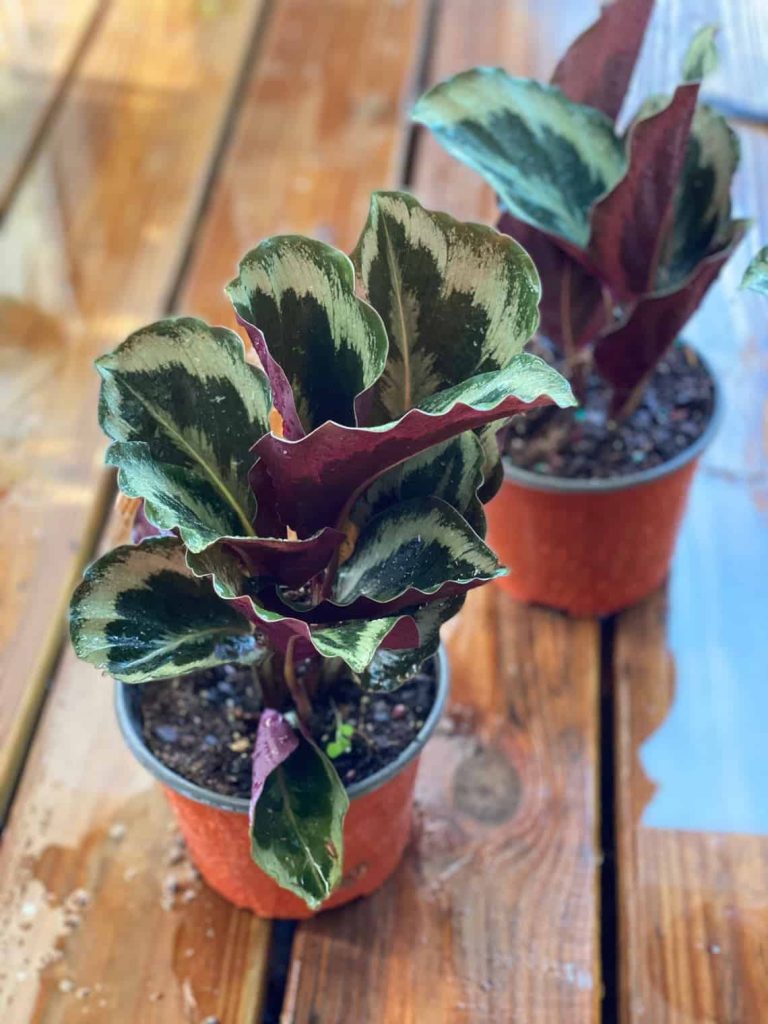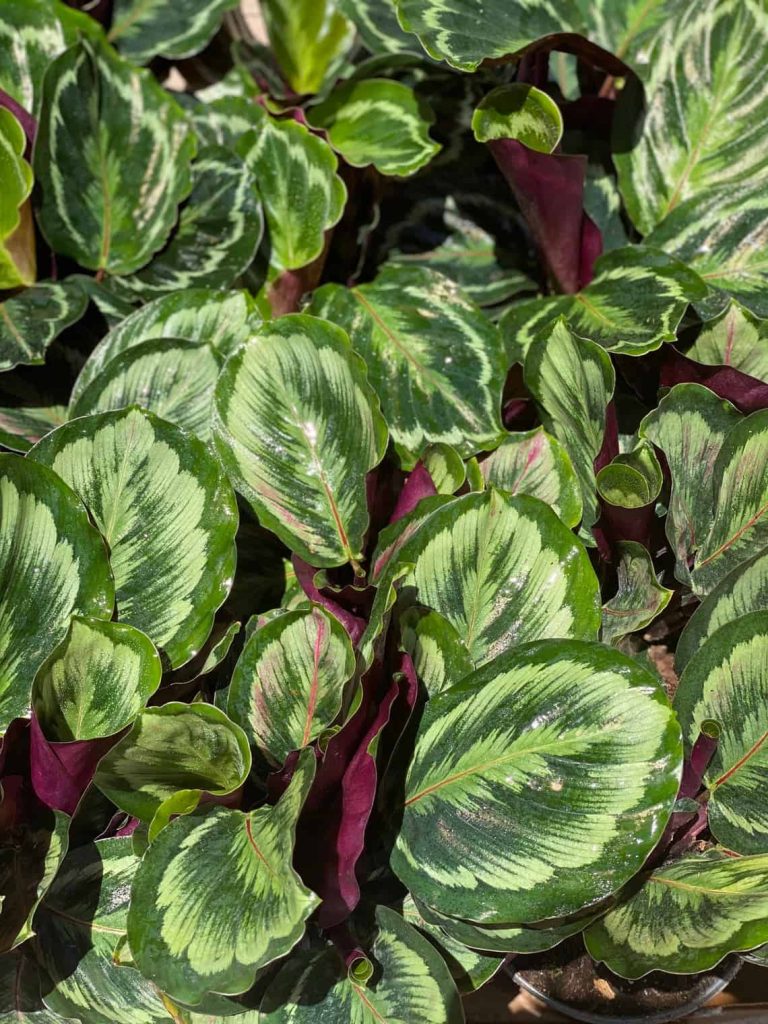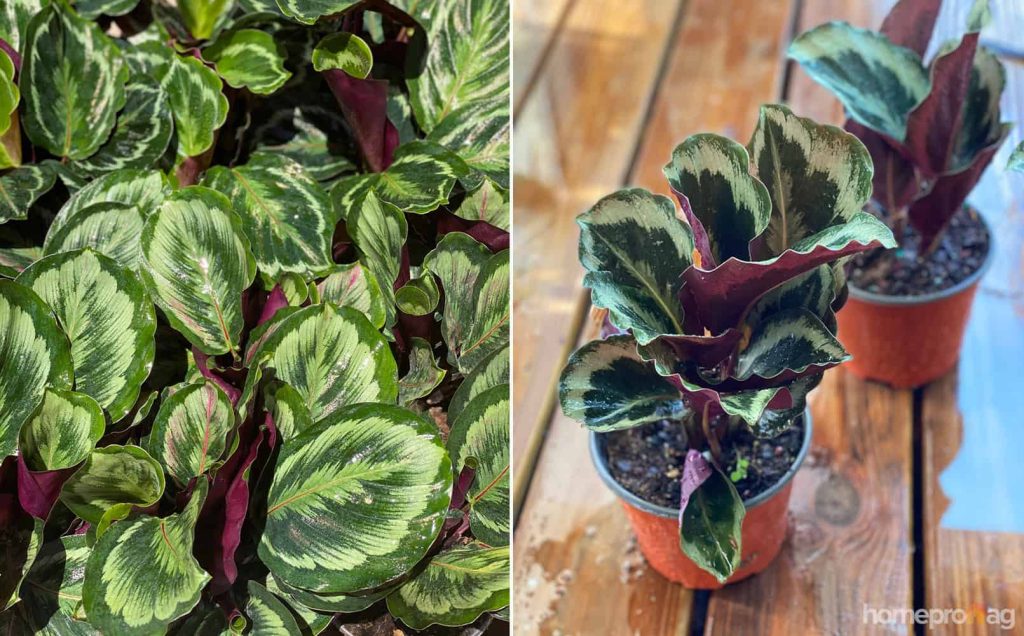When asked which genus has the most beautiful plants, we do not think twice before mentioning the calathea. No doubt, this genus is blessed with some of the most intriguing plants that you can grow indoors.
The calathea plants are mainly characterized by the strokes on their lush green leaves. One of our favorite calathea plants is the calathea medallion. We especially think the calathea medallion is an exceptional plant because of its beautiful oval, large green leaves with lovely patterns on them.
The plant also reveals burgundy beneath it, this is usually obvious when the plant raises its leaves at night, in the calathea’s usual prayer posture. Did you know the calathea plant is also known as the prayer plant?
Calathea medallion can be grown indoors, however, growing the medallion variety requires certain specialties, skill, and perseverance. This makes the plant not suitable for beginner gardeners.
We know how much you will love to have this beauty in your home or office, we have provided the right care and propagation guide for the calathea medallion.
Calathea Medallion Explained
| Common name | Calathea medallion |
| Botanical name | Calathea veitchiana |
| Plant type | Flowering plant |
| Soil type | Well-draining soil |
| Soil Ph | 6.5 |
| Temperature | 65 to 80 degrees F |
| Water | Moderate watering |
| Light | Bright, indirect light |
| Native | Ecuador, South America |
| Toxicity | Non-toxic. |
Calathea medallion, also known by its botanical name, calathea veitchiana, a native of Ecuador, South America. The calathea medallion is known for its beautiful oval-shaped leaves. A variety of the genus calathea is popularly regarded as a prayer plant, like their relatives, the maranta.
The calathea can grow to about 3 feet tall. Although the medallion is everything you want in a houseplant, it is not as easy to grow as you would expect. However, we have provided the best care and propagation guide for your calathea medallion.

Calathea Medallion Propagation Methods
Like other calathea plants, the calathea medallion plant can be propagated via division. This indicates that you can have as many medallions plants as possible in the easiest ways, provided your mother plant is healthy. Follow the steps below to successfully propagate your calathea medallion.
- Identify a healthy and mature plant.
- Take it out of its pot and lay it aside on a surface.
- Carefully separate the plant’s roots from the dirt. While doing this, make sure the roots don’t get lost in the dirt.
- Divide the plant into two, or more if you have a big plant. Make sure each cutting is attached to the roots.
- Prepare containers with soil and place the plants in their respective soils.
- Keep the soil moist, however, it shouldn’t be soggy. In 4 weeks, your plant should be well-rested in its new home.
We recommend that you perform the propagation method when the plant is due for repotting, it should also be early spring, before the growing seasons.
Calathea Medallion Plant Care
Taking care of the calathea medallion requires a specific skill, this is why the plant is not suitable for beginner planters. You need to follow a specific and the best care guide. Lucky you! We have provided a detailed care guide for you to care for your medallion successfully.
1. Light
The calathea plants enjoy being placed in bright, indirect light and medallion is not an exception. We recommend placing them in the morning sun for about 6 hours.
Prevent and shield the medallion plant from the afternoon sun or direct sunlight, your plant will suffer if they are exposed to this amount of light, and its leaves can become scorched and pale. You can place them in the afternoon sun during the winter, this will not harm them.
The plant will also not tolerate being placed in shade; its growth will be hindered.
2. Water
Do you want to keep your medallion happy? Then you have to water it properly. The Calathea plants always want to be watered adequately and in the right measure. Your calathea plant wants to be moist and also well-drained, you cannot leave the plant soggy as they are susceptible to having root rot.
Always check, with your finger, the top 2 inches of the soil to determine if it is dry and easy to be watered.
Creating a watering schedule will reduce the stress of going to check often before it gets dry. By our calculations, this way of watering will sum up to watering once or twice a week. Many other factors, such as the soil, location, will also determine how to water. We advise that you water less during the cold seasons.
3. Humidity
Calatheas enjoy high humidity levels and nothing less should be provided. Your plant may not survive with the normal indoor air as it is mostly dry, hence you will be required to provide adequate other means for humidity for your plant. Humidity can be provided by either misting your plant regularly, pebble trays, purchasing a humidifier or you can grow your plants together.
Plants are known to provide moisture when they “breathe”, and grouping plants (tropical) can make the environment humid enough for their growth.
4. Temperature
The best temperature range for your calathea medallion is between 65 degrees F to 80 degrees F, the plant should not be placed in temperatures below 55 degrees F.
You can also place them at average room temperature, they should be kept away from hot weather, radiators, AC vents. Medallion does not do well with sudden temperature changes. Placing them in cold drafts will cause the leaves to wilt. If you are growing them outdoor, in the summer, bring them indoors, at night.
5. Soil
Like a member of the calathea family, the medallion prefers a well-draining, nutrients full soil. Because the plant prefers water, the soil must be able to drain water fast and retain moisture. We recommend you make a mix of perlite, peat moss, and potting soil, to provide the nutrients and also enable drainage. Other organic matters such as charcoal, orchid bark, etc. Can be added. We advise that you avoid soils with too many composts, to prevent fungus gnats.

6. Fertilizer
Calathea medallion will not mind being fed once in one month; this should be done during the growing seasons. Make use of liquid, balanced houseplant fertilizer, ensure you dilute it to a quarter its strength.
Do not fertilize your plant during the winter, this is because most tropical plants become dormant during this season and do not require feeding. Overfertilizing your plant can cause harm to it.
FAQs
Is Calathea Medallion Toxic?
No! the calathea plants are known to be friendly to pets and animals. This means that it is in no way toxic to your pets and humans.
Why Are Calathea Medallion Leaves Yellow?
The most common reason for your medallion turning yellow is overwatering, however, other causes are pest infestation, underwatering, drafts. Observe your plant to be sure of the cause, if you have found the cause to be overwatering, ensure your plant dries completely before you water it. You should also adjust appropriately if the cause is not over-watering.
Why Are Medallion Leaves, Turning Brown?
Brown leaves can be a result of thrip infestation. There are probably tiny black insects beneath your leaves and their stem. Good thing is, that this can be treated with the use of neem oil.
Why Do My Medallion Leaves Have Brown Edges?
Brown edges can be attributed to moisture issues, especially underwatering and low humidity. We recommend that you provide your plant with enough water, you should also mist your plant, preferably with distilled or filtered water.
Why Do Calathea Medallion Leaves Curl Up?
Curling leaves is an indication that your plant lacks water. Be reminded that your plant wants to be well-drained, however, it shouldn’t be dry. Not watering your plant as often as you should causes its leaves to curl up, trust us, this doesn’t look good. Thoroughly water your plant and mist the leaves with distilled leaves to correct this.
My Calathea Leaves Are Dying, What Should I Do?
We recommend that you first, check for signs of pests, that may be the cause of your plant’s state. You should also check your watering schedule; water is really important to calathea. Re-potting is also an escape route, do this so your plant moves to a new and better condition.
Final Thoughts
We know you cannot resist having a calathea in your home, we can’t too. We, however, want you to get it right and grow a healthy plant. Following the best care guide above will ensure your plant stays healthy. Check the tips below to further help you.
- We recommend cleaning your plant, as often as you can. This will keep your plant shiny and also clean off some pests on your plant’s leaves.
- Re-potting allows your plant to experience fresh soil and nutrients. We advise that you re-pot once in a year or two years. Ensure your pot is an inch bigger than the previous one.
- Pruning helps trim off older plants and keep them happy. Ensure to get rid of damaged and dead leaves.
Read next: Swiss Cheese Plant (Monstera Deliciosa) Varieties, Propagation, And Care

